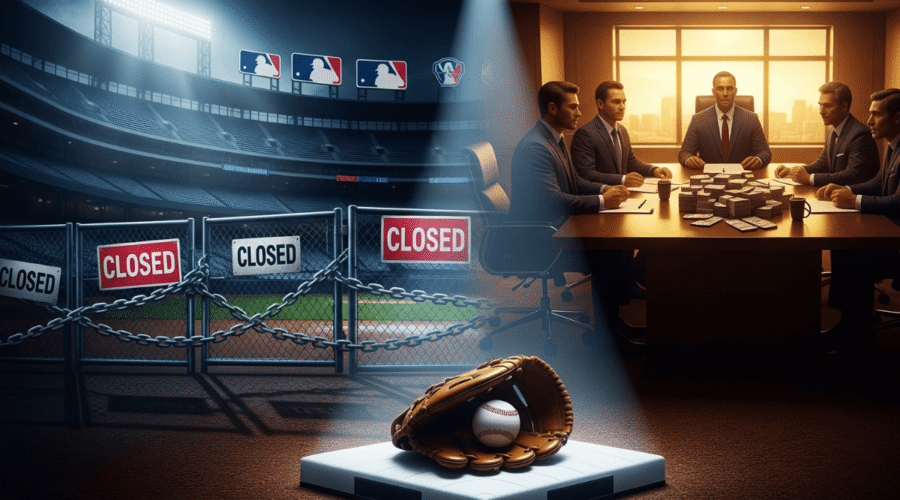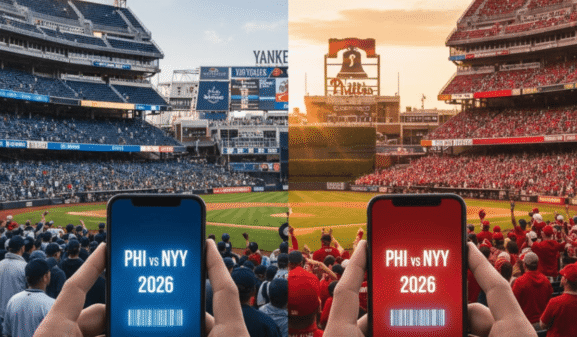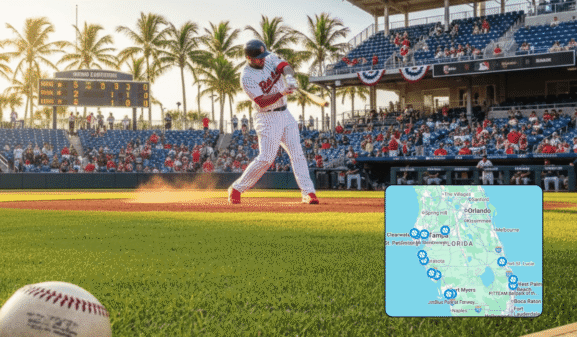Will There Be an MLB Lockout in 2026? Predictions, Rumors, and Schedule Implications
Baseball fans are facing an uncomfortable reality: a likely lockout in December 2026 appears increasingly inevitable as Major League Baseball and the players’ union prepare for what could be the most contentious labor negotiations in decades. With the current collective bargaining agreement expiring on December 1, 2026, the stage is set for a showdown that could fundamentally reshape America’s pastime.
The writing is on the wall, and it’s not pretty. Players, owners, and industry insiders are already bracing for what many believe will be an unavoidable work stoppage that could disrupt the 2027 season and beyond.
Quick Takeaways
- MLB lockout in December 2026 appears likely with players and owners already expecting work stoppage
- Salary cap proposals from ownership face fierce resistance from players’ union leadership
- Massive payroll disparities ($326M Mets vs $69M Marlins) fuel competitive balance concerns among fans
- Players’ union has prepared “war chest” of licensing money specifically for potential 2026 negotiations
- Regional sports network revenue crisis creates additional pressure for economic restructuring
- Industry experts predict “90%” chance of lockout occurring when current agreement expires
The Salary Cap Battle Lines Are Drawn
The central issue driving toward a 2026 lockout isn’t subtle: money, and lots of it. Commissioner Rob Manfred and team owners are pushing hard for fundamental changes to baseball’s economic structure, including the sport’s first-ever salary cap. This represents a seismic shift for a league that has operated without spending limits since its inception.
Depending on calculation method, the New York Mets’ 2025 opening payroll is estimated between $323 million and $339 million; Juan Soto’s 15-year, $765 million deal remains MLB’s largest contract. Meanwhile, the Miami Marlins operated with just $69 million – nearly five times less. The Los Angeles Dodgers, despite their $400 million luxury tax payroll, continue setting new spending records while smaller market teams struggle to compete.
“When I talk to the players, I don’t try to convince them that a salary cap system would be a good thing,” Manfred admitted. Instead, he frames it as addressing “a problem in the media business” and competitive balance issues that leave fans in smaller markets feeling hopeless before seasons even begin.
The players’ union, led by Tony Clark, remains adamantly opposed. “A cap is not about a partnership. A cap isn’t about growing the game,” Clark declared. “A cap is about franchise values and profits… It doesn’t reward excellence. It undermines it from an organizational standpoint.”
Players and Insiders Expect the Worst
The baseball community isn’t just preparing for negotiations – they’re preparing for war. “No one’s talking about it, but we all know that they’re going to lock us out for it, and then we’re going to miss time,” said Mets All-Star Pete Alonso, capturing the resignation many players feel about the upcoming battle.
Veteran baseball insider Ken Rosenthal puts the lockout odds at “90 percent,” though he emphasizes this doesn’t guarantee missed games or an extended work stoppage. Still, the pessimism is palpable throughout the industry.
The players’ union has strategically built a “war chest” from licensing fees from baseball cards, video games, and merchandise specifically to help non-star players weather a potential work stoppage. The union’s executive board voted to withhold 100% of 2024 licensing money to prepare for these negotiations, indicating they’re taking the threat seriously.
Read more: MLB Realignment 32 Teams : Rumors & schedule updates that could reshape MLB rivalries
The Regional Sports Network Crisis Adds Fuel to the Fire
Beyond the salary cap debate, baseball faces a media revenue crisis that’s creating additional pressure for economic restructuring. The collapse of regional sports networks has created massive disparities in local media revenue between teams. Under its restructured Bally Sports deal, the Dodgers now earn roughly $250 million–$300 million in local media rights, while the Marlins receive about $50 million following RSN bankruptcies and rights renegotiations.
This disparity directly feeds into the competitive balance argument. As fewer people subscribe to cable bundles and regional sports networks face bankruptcy, the traditional model that has sustained baseball’s local revenue streams is crumbling. Early predictions indicate potential labor disputes that could fundamentally alter the 2026 season structure as both sides grapple with these underlying economic pressures.
Read more: Red Sox 2026 Schedule Release Date: Predictions and Rumors for Boston Fans
What a 2026 MLB Lockout Schedule Could Look Like
If negotiations break down as expected, the timeline becomes predictable based on recent history. The current CBA expires at 11:59 PM on December 1, 2026. Following the pattern from the 2021-2022 lockout, owners would likely implement an immediate work stoppage, freezing all player transactions and halting preparation for the 2027 season.
During the last lockout, negotiations lasted 99 days before reaching resolution on March 10, 2022, just 27 days before Opening Day. A similar timeline in 2026-2027 could push resolution into March 2027, potentially delaying or shortening the regular season if talks extend longer.
The worst-case scenario involves missing regular season games for the first time since the devastating 1994-1995 strike that canceled the World Series. However, both sides understand the financial and public relations catastrophe that would represent for a sport still recovering from that historical low point.
The Stakes Have Never Been Higher
What makes the 2026 negotiations particularly precarious is the fundamental nature of the disagreements. This isn’t about tweaking luxury tax thresholds or minor rule changes – it’s about restructuring the entire economic foundation of professional baseball.
Manfred has noted that 10% of players earn 72% of salaries, highlighting the concentration of wealth among superstars. While owners propose salary cap systems that might include salary floors and guaranteed revenue percentages for players, the union views any spending restrictions as “institutionalized collusion.”
The irony isn’t lost on anyone: baseball is more economically healthy than ever, with record revenues of $12.1 billion for the 2024 season. Yet underneath this success lies an economic bubble that many believe is unsustainable without structural changes.
Agent Scott Boras aptly compared management’s salary cap proposals to a “gingerbread house” designed to lure players into a trap they’ve successfully avoided for decades. The 1994-1995 strike proved players’ willingness to sacrifice entire seasons to prevent a salary cap, and their resolve appears unchanged.
Conclusion
The question isn’t whether there will be labor tensions in 2026 – it’s whether both sides can find common ground before those tensions explode into a work stoppage that damages the sport. With players already resigned to a lockout and owners determined to implement fundamental economic changes, the stage is set for baseball’s most consequential labor battle in three decades.
Commissioner Manfred, whose tenure ends in 2029, has stated his hope to “keep that record intact” of never missing games during his leadership. However, the mathematical reality of irreconcilable positions on salary caps suggests that record faces its greatest test yet.
Baseball fans should enjoy the next two seasons under the current agreement because the storm clouds gathering over 2026 show no signs of clearing. The only question remaining is whether the inevitable collision will result in a brief winter lockout or something far more damaging to America’s pastime.
FAQ
Q: When does the current MLB collective bargaining agreement expire?
A: The current CBA expires on December 1, 2026, at 11:59 PM, setting up potential negotiations during the 2026-2027 offseason.
Q: What are the main issues likely to cause a 2026 MLB lockout?
A: The primary issue is ownership’s push for baseball’s first-ever salary cap, which the players’ union strongly opposes. Additional factors include massive payroll disparities between teams and the regional sports network revenue crisis.
Q: How likely is an MLB lockout in 2026 according to experts?
A: Baseball insider Ken Rosenthal estimates a 90 percent chance of a lockout when the current CBA expires in December 2026, while players like Pete Alonso have stated they expect to be locked out and miss time.
Q: How are players preparing for a potential 2026 lockout?
A: The players’ union has built a “war chest” from licensing fees and voted to withhold 100% of 2024 licensing money specifically to help players during potential work stoppages.
Q: Could the 2027 MLB season be delayed or shortened due to a lockout?
A: Yes, if negotiations follow the 2021-2022 pattern of lasting several months, the 2027 season could face delays or, in a worst-case scenario, missed games for the first time since 1995.


